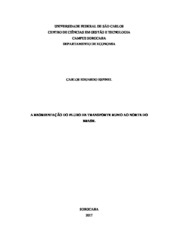Mostrar el registro sencillo del ítem
A reorientação do fluxo de transporte rumo ao norte do Brasil
| dc.contributor.author | Campos, Carlos Eduardo Espinel | |
| dc.date.accessioned | 2021-02-05T19:36:43Z | |
| dc.date.available | 2021-02-05T19:36:43Z | |
| dc.date.issued | 2017-12-06 | |
| dc.identifier.citation | CAMPOS, Carlos Eduardo Espinel. A reorientação do fluxo de transporte rumo ao norte do Brasil. 2017. Trabalho de Conclusão de Curso (Graduação em Ciências Econômicas) – Universidade Federal de São Carlos, Sorocaba, 2017. Disponível em: https://repositorio.ufscar.br/handle/ufscar/13821. | * |
| dc.identifier.uri | https://repositorio.ufscar.br/handle/ufscar/13821 | |
| dc.description.abstract | The objective of this research is to analyze the economic impacts of the reorientation of the national transport flow towards the ports of the North, as it is currently concentrated in the ports located in the South and Southeast of the country. Through an analysis of the freight prices and export volume of the soybean from the Central West Region to the ports of the North and South and Southeast of Brazil, it was possible to establish efficiency gains, which supported the shocks applied through a computable general equilibrium model, to identify the direct and indirect effects of this possible reorientation trough North. The results indicated that there are gains caused by a possible redirection of the transport flow, however, as a rule, they concentrate income and benefit mostly the Central West Region. Thus, competitive gains obtained by this region are in detriment of the other regions of the country. In addition, the economic impacts of the shocks did not present a high intensity, since the "transport" input, where the efficiency shock was applied, is only one among the various inputs used in soybean production. The alternative of increasing the transport flow trough the North has been shown effective, but not enough to fix the logistical deficit that challenges the Brazilian agribusiness performance. Therefore it is necessary to combine this reorientation with other measures that may bring greater dynamism to the country. | por |
| dc.description.sponsorship | Não recebi financiamento | por |
| dc.language.iso | por | por |
| dc.publisher | Universidade Federal de São Carlos | por |
| dc.rights | Attribution-NonCommercial-NoDerivs 3.0 Brazil | * |
| dc.rights.uri | http://creativecommons.org/licenses/by-nc-nd/3.0/br/ | * |
| dc.subject | Soja | por |
| dc.subject | Fretes | por |
| dc.subject | Modelo de Equilíbrio Geral Computável | por |
| dc.subject | Soybean | por |
| dc.subject | Freights | por |
| dc.subject | Computable General Equilibrium Model | por |
| dc.title | A reorientação do fluxo de transporte rumo ao norte do Brasil | por |
| dc.title.alternative | Regional impacts of the increasing grain exporting flow through Brazilian Northern ports | por |
| dc.type | TCC | por |
| dc.contributor.advisor1 | Castro, Eduardo Rodrigues de | |
| dc.contributor.advisor1Lattes | http://lattes.cnpq.br/5702172673123334 | por |
| dc.contributor.advisor-co1 | Gurgel, Angelo Costa | |
| dc.contributor.advisor-co1Lattes | http://lattes.cnpq.br/1368894778228852 | por |
| dc.description.resumo | O objetivo da presente pesquisa é analisar os impactos econômicos da reorientação do fluxo de transporte nacional rumo aos portos do Norte, uma vez que atualmente, este é concentrado nos portos localizados no Sul e no Sudeste do país. Através de uma análise dos preços dos fretes e volume de exportação da soja do Centro-Oeste para os portos do Norte e Sul e Sudeste do Brasil, foi possível estabelecer ganhos de eficiência, que embasaram os choques aplicados através de um modelo de equilibro geral computável, com o intuito de identificar os efeitos diretos e indiretos desta possível reorientação via Norte. Os resultados indicaram que existem ganhos provocados por um possível redirecionamento do fluxo de transporte, contudo, via de regra, estes são concentradores de renda e condensados na Região Centro-Oeste. Sendo assim, os ganhos de competitividade obtidos por esta região se dão em detrimento das demais regiões do país. Ademais, os impactos econômicos dos choques foram de baixa intensidade, uma vez que o insumo “transporte”, onde o choque de eficiência foi aplicado, é apenas um dentre os diversos insumos utilizados, na produção de soja. A alternativa de escoar o fluxo de transporte rumo ao Norte, portanto, provou-se eficaz, mas não suficiente para sanar o déficit logístico que desafia o desempenho do agronegócio brasileiro, sendo necessário aliar esta reorientação, a outras medidas que acarretem maior dinamismo para o país. | por |
| dc.publisher.initials | UFSCar | por |
| dc.subject.cnpq | CIENCIAS SOCIAIS APLICADAS::ECONOMIA::ECONOMIA REGIONAL E URBANA::ECONOMIA REGIONAL | por |
| dc.subject.cnpq | CIENCIAS SOCIAIS APLICADAS::ECONOMIA::ECONOMIA REGIONAL E URBANA | por |
| dc.subject.cnpq | CIENCIAS SOCIAIS APLICADAS::ECONOMIA::ECONOMIAS AGRARIA E DOS RECURSOS NATURAIS | por |
| dc.subject.cnpq | CIENCIAS SOCIAIS APLICADAS::ECONOMIA::METODOS QUANTITATIVOS EM ECONOMIA | por |
| dc.publisher.address | Câmpus Sorocaba | por |
| dc.contributor.authorlattes | http://lattes.cnpq.br/9466405488124487 | por |
| dc.publisher.course | Ciências Econômicas - CEc-So | por |

